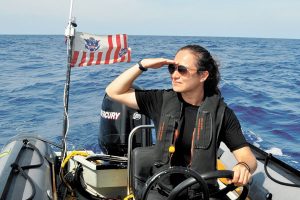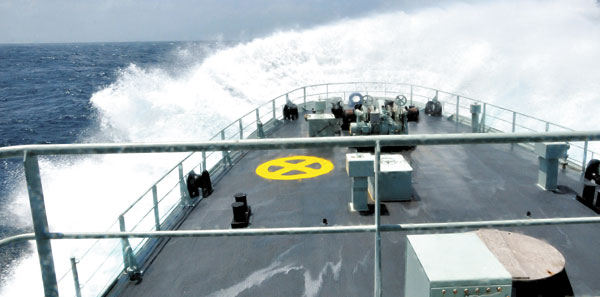First time at sea
By Lookout on Aug 15, 2016 with Comments 0

Lieutenant (Navy) Linda Coleman aboard a rigid-hulled inflatable boat during Op Caribbe.
Lt(N) Linda Coleman, DND ~
What is it like learning to be a sailor in the Royal Canadian Navy (RCN) and going to sea for the first time after years in a Canadian Army uniform?
Back in February, I was new to the navy and going through the Naval Environmental Training Program (NETP) to prepare for my first naval deployment as the Public Affairs Officer for Operation Caribbe, Canada’s participation in the multinational campaign against illicit trafficking in the Caribbean Sea and eastern Pacific Ocean.
I completed NETP on March 1 and left the next day for San Diego, California, to meet up with HMCS Saskatoon and Edmonton to start the operation. I barely slept in the days leading up to my arrival, and the days following. Despite completing NETP, I was excited, nervous and a little terrified about experiencing the real deal.
Even though NETP taught me how to fight fires and floods, it certainly didn’t prepare me for day-to-day life at sea. I contacted every sailor I knew asking for advice and tips on everything from wardroom etiquette to what kind of pajamas to bring. For example, I was told to bring a bathrobe. If I didn’t ask, no one would have told me, and that would have made for an awkward deployment without one. What were some of the best tips I received? Shower flip flops, reading material, music, lap top with movies/TV shows, and a soft fleece blanket ranked pretty high for me.
Upon joining Saskatoon, I realized that my first mistake was over packing too many civilian clothes (my family and friends would not be surprised by this news). I luckily managed to fit everything into my tiny locker, which was in a cabin I shared with three other female crew members who ended up being fantastic women to serve with.
The mistakes kept coming and for the first week I couldn’t even count the amount of times I had the ship’s coxswain, Petty Officer 1st Class Kevin Parent, say “ma’am, you can’t stand there”, “ma’am, you have to wear your hat on the bridge”, “ma’am, don’t walk over the ropes”, and it went on and on. I took it as a compliment that he was just looking out for me (or so I like to think).
It took a long time to get used to the noises on a ship. There were so many unfamiliar sounds, including pipes, alarms and engines. Pipes were originally used to give orders on warships when shouted orders could not be heard. The piping was done by the ship’s boatswain and therefore the instrument is known as the boatswain’s pipe or boatswain’s call. This is still prominent in the navy today, and pipes are heard all day long from “wakey wakey” to the end of the day.
Then at night while trying to sleep, I would notice this constant buzzing sound. The best way I can describe it is imagining yourself stuck in a small hotel room with a really loud air conditioning unit that you can’t turn off. Later on during the deployment this noise became soothing as it meant the ship was working as it was supposed to.
And, of course, there’s the motion. Maritime coastal defence vessels (MCDVs) aren’t the most stable platforms and it doesn’t take much for them to bob around like a cork. I personally found sleeping a bit of a challenge during a bad sea state. Taking a shower is also interesting, and I’ll admit that I hit my head a few times.
Since my return, I’ve had many questions from family and friends about what it’s like to serve on a warship. I’ve decided to put to paper my answers, in the hopes they might help future sailors prepare for their first sail.
Did I get sea sick?
I was completely stressed out about getting sea sick, so I brought all kinds of patches and potions. Yes, I went a little overboard. When we hit rough seas shortly after my arrival, I patiently waited to start feeling sick and kept a “barf bag” in my pocket just in case. Crew members aren’t allowed to throw up in the toilets on board as it will clog up the pipes, so it’s either in a bag, or over the side of the ship. I kept waiting and waiting, and eventually it hit me that I wasn’t going to be sick. Hallelujah! I don’t get sea sick. The worst I experienced was minor headaches. My mother has a reputation for never getting sea sick even in gale-force storms, so perhaps I inherited that from her.
How was the food?
The RCN is known for having excellent cooks and Saskatoon had some of our best. The quality and variety was much better than I expected. It was so good that the United States Coast Guard Law Enforcement Detachment embarked with us recognized our cooks with a special coin at the end of the deployment, adding it was the best food they’ve had on Op Caribbe, and this was their seventh deployment.
So what did we eat? Steak, lobster, stuffed peppers, butter chicken, salads, sandwiches, salmon, tacos, pulled pork, stir fry, ribs, turkey, chicken…you get the idea. And, of course, there’s the traditional soup every morning at 10 a.m., and duff (dessert) is served every night after supper. Let’s just say that I was very thankful there was a gym on board!
What is a day at sea like?
In my opinion, sailing is like the movie Groundhog Day. It hit me early on in the deployment that I was going to be waking up, eating and doing the same things at the exact same time every single day. There’s no weekend to look forward to, no sleep-ins, and you exercise the same drills all the time. It’s also hard to keep track of what day it is. When at sea, everyday can feel like a Monday. But I eventually learned to embrace Groundhog Day and enjoyed the routine I set up for myself. I especially looked forward to my daily workout in the gym, which is located behind the bridge on an MCDV. How often in life do you have the opportunity to work out with an ocean view?!
How did I bond with my shipmates?
The MCDVs are small ships, with a crew of only 46. I ended up appreciating this aspect of sailing in an MCDV, especially for my first sail. It’s much less intimidating than joining a frigate with a crew of more than 200.
The crews of MCDVs are mixed Regular and Reserve Force and tend to be closer knit, and there’s less of a divide between the officers and non-commissioned members. This was the case for HMCS Saskatoon and I feel lucky to have served with such a fantastic and welcoming crew.
That being said, living and working on a warship for long periods of time is not a normal environment. If you’re having a bad day, there is literally no escape except for in your rack (bunk) with the curtain drawn, which kind of feels like an oversized coffin (and I mean this in a positive way). After sleeping on cots or on a pile of leaves in the woods while being bitten by mosquitoes all night when in the army, my sleeping accommodations on the ship felt quite luxurious.
Of course there are days when not everyone gets along. I accidentally threw out someone’s tea after I was tasked to clean out the wardroom. There was no name on it and it had an expired date. Unfortunately, it did belong to someone and that person was visibly upset. News spread throughout the ship about the incident and it became known as “tea gate.” Would this have been a big deal if we weren’t stuck in the middle of the ocean with the same people 24/7 for an extended period of time? Probably not. But that’s life at sea.
What surprised me most?
What surprised me the most was gaining a new appreciation for the ocean. It is truly beautiful out there, sometimes even majestic. Seeing marine life, watching sunsets and star gazing were my favourite parts of the entire experience. I made an effort to ensure I was outside at some point every day to take it all in.
I’ll never forget the day when the waves were extremely long and drawn out, it looked as if the ocean was breathing. Other times the ocean was as flat as a lake and you could see sea turtles swimming by. For most sailors, it’s just another day at the office. I, on the other hand, spend most of my career working in an office cubicle, so this aspect of sailing fascinated me. The ocean, fresh air and daily sunshine made me feel healthy, happy and alive. It was a struggle to return to cubicle life after the deployment.
Overall, like on any deployment, you have good days and bad. Having support on the home front helped tremendously. My father, a retired army colonel, was especially curious of my experiences. He originally wanted to join the navy, but learned he was colour blind during the recruiting process and was declined. What’s ironic is that later in life he learned that he suffers from severe sea sickness. “I would never have been able to do what you’re doing and I’m so proud of you,” he told me while I was deployed, which still makes me teary-eyed.
My common-law partner, who is also in the navy, would sometimes console me on days when I was feeling down by saying “even though time is dragging on now, you will be able to look back on your contributions and successes with pride and very fond memories,” and he was so right. Thinking back, my first naval deployment ended up being an incredible experience with memories that will last a lifetime.
I sailed with Saskatoon for 51 days in the Eastern Pacific along the coast of Central America. It was a successful deployment where our ship, along with Edmonton, assisted in the seizure or disruption of more than 3,900 kg of cocaine. I feel like I can now wear the navy uniform with pride.

HMCS Saskatoon sails in heavy seas during Op Caribbe. Photo by Public Affairs Officer, Op CARIBBE
Filed Under: Top Stories
About the Author:





